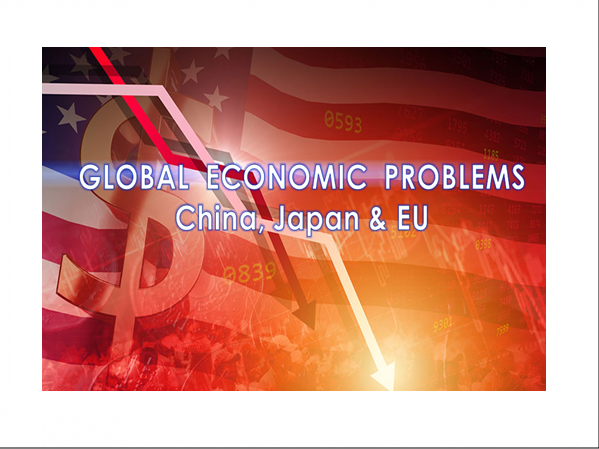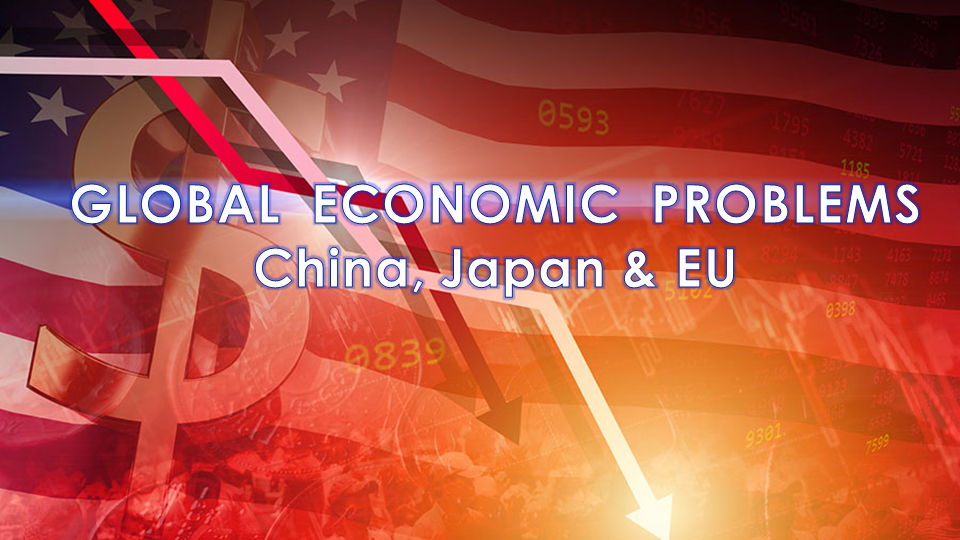IN-DEPTH: TRANSCRIPTION - UnderTheLens – 09-21-22 - OCTOBER – Global Economic Problems – China, Japan & EU
SLIDE DECK
TRANSCRIPTION
SLIDE 2
Thank you for joining me. I'm Gord Long.
A REMINDER BEFORE WE BEGIN: DO NO NOT TRADE FROM ANY OF THESE SLIDES - they are COMMENTARY for educational and discussion purposes ONLY.
Always consult a professional financial advisor before making any investment decisions.
COVER
The market shocks stemming from the 2000 Dotcom Bubble popping and the Financial Crisis of 2008 were primarily US problems which spilled over into the global economy.
Today we have stability problems in the global economy which are spilling over into an unstable US economy.
AGENDA
In this session I want to briefly highlight the destabilizing global problems we are facing and what they are likely to mean in the short, intermediate and longer term.
As such I want to cover the areas outlined as shown here.
SLIDE 5
There are always the doomsayer Cassandra’s warning investors of pending doom. In fact I have been accused of that, though I see myself as an Investor with a strong focus on “Risk Mitigation” and the clear understanding of what and where the risk lies when making investment decisions.
I follow closely Warren Buffett’s sage three investment rules:
Rule 1: Don’t lose Money,
Rule 2: Don’t lose Money,
Rule 3: Never forget Rule #1 & #2!
SLIDE 6
What I have noticed this year is that we are witnessing Institutions, Corporations, Buy-Side Analysts and Market pundits, who are incented to talk a positive market story, now instead warning of serious problems ahead for the global economy.
The United Nations, World Bank, IMF and OECD have noticeably gone to the dark side.
SLIDE 7
Last week FedEx shocked the global markets when it warned it was seeing indications of a coming worldwide recession. As a result FedEx has halted forward guidance until they better understand the dramatic slowdown they are witnessing. Few have a better sense of what is happening than players like FedEx where 15% of US GDP goes through their logistics shipping system on a daily basis.
SLIDE 8
Additionally, financial CEOs like Jamie Dimon are warning and preparing as JP Morgan is for something potentially worse than a recession. Likewise Goldman Sachs has seen production “fall off a cliff” and has started layoffs.
Wall Street layoffs have always proven a “Canary in the Coal mine” as skilled people are their primary asset and are extremely difficult, time consuming and expensive to replace.
Also when I also hear perennial market Bulls like Jim Cramer at advertiser sensitive and leading market cheerleading site CNBC warning, you know something is seriously amiss!
SLIDE 9
What has changed is that the Global central banks (with the noticeable exception of Japan) are once again simultaneously attempting to tighten financial conditions. This month will be the first month that the Federal Reserve starts Quantitative Tightening in earnest as it withdraws liquidity from the markets.
Even the Word Bank is cautioning and I quote:
"The global economy may face a recession next year caused by an aggressive wave of policy tightening that could yet prove inadequate to temper inflation"
SLIDE 10
The global economic problems are most evident and most potentially dangerous in three areas where plummeting currencies signal problems:
The Chinese Yuan has fallen hard as a collapsing residential housing sector, Zero-Covid and an industrial crippling electrical energy shortage take their tolls.
SLIDE 11
The Japanese Yen has broken critical support as monetary policies of Yield Curve Control and maintaining a target 0.25% yield level ravage the Yen, while Inflation for the first time in over three decades becomes a legitimate concern for Japanese Consumers and a highly import oriented economy.
SLIDE 12
The biggest problem may lie in the EU where the Euro has also broken through major long term support levels. Unprecedented Energy and Food shortages, out of control inflation, the Ukraine War and unresolved structural issues are taking their toll.
SLIDE 13
The weakness in these Currencies has caused a “Flight-to-Safety” to the US Dollar. The US dollar as the world’s reserve currency is up ~16% in 2022. This is a shock which is destabilizing too many Emerging and Frontier economies that typically borrow in US dollars and must pay for that debt in steadily devaluing local currencies. Often as commodity centric economies they are forced to push commodity prices up if they have any pricing power to do that.
It all becomes a domino effect.
SLIDE 14
In case you think this is good for the US it is both a good news; bad news story.
The good news is Inflation could be much worse in the US if it wasn’t for the strong dollar holding down consumer & industrial import costs. The bad news is it is spiking real rates which are driving US lending rates higher, even before the US truly activates it heavy handed QT program.
Something has to give, and as such we at MATASII are closely monitoring US Credit, Real Rates and the US dollar to see how long a 70% consumption economy like the US can hold up. There are clear signs that the US consumer is nearly tapped out as high Credit Card rates are now cutting into a depleting disposable income.
SLIDE 15
The US has been near tipping points on a number of instances over the last decade. Each time a strong Chinese Economy pumped liquidity in the overall global economy.
SLIDE 16
Specifically, there have been four prior instances starting with the 2008 Financial Crisis, where the Chinese economy and monetary policies saved the global economy. This helped the global economies avoid economic slowdowns and potentially resulting in regional or possibly a global recession.
SLIDE 17
These interventions have coincided with financial market weakness. Markets that are highly leveraged and exposed to slowing growth
The question is whether China will come to the rescue again?
SLIDE 18
Actually, the real question is whether China CAN come to the rescue again?
China has serious issues for the first time since it entered the World Trade Organization (WTO) in 2002.
Though China was recently concerned with and trying to halt growing financial speculation, it was forced to abruptly reverse course as the residential housing crisis hit the Chinese economy. The Evergrande debacle is only the beginning of potential cascading dominos.
But will China’s pivot be enough to help the overall global economy again? So far it appears it is going to fall short.
SLIDE 19
One of the problems China faces is that the cumulative stimulus since 2007 is taking its’ toll. Unlike the US, China is not a consumption economy. It is currently an Investment and Capital Formation economy – that is the “I” in the GDP formula. The problem is that investment capital has been plowed into non-performing real estate, ghost cities, and speculative infrastructure. More stimuli for more non-performing infrastructure and real estate is simply not going to be the solution.
SLIDE 20
To put the magnitude of the exposure in perspective, China’s Residential Housing Sector is the largest asset class in the world, valued at ~$62T
Exports (that is finished goods) are only slightly larger than Imports (the raw materials to produce them) with profit margins being razor thin. This means the net GDP for Import/Exports is relatively small for China. Consumption is also relatively small. Investment and Capital Formation is the driver!!!
SLIDE 21
What China is experiencing with its current residential real estate problem is already worse than the US’s 2008 Financial Crisis on a percentage basis which was also driven by housing and real estate. However, Chinese the numbers are much larger than simple percentages effectively reflect.
SLIDE 22
The Price-to-Income ratio on the right side of this graphic show how truly expensive real estate is. In China real estate is the primary investment & speculative tool of the masses whereas in other economies there are much more diversified alternatives.
SLIDE 23
Basically, China has built an economy with all its eggs in one basket and the bottom has come out of an over-stuffed and rotting basket!
There is a real question whether China can halt or even control the implosion presently occurring in the real estate sector. China has the wealth but this is a structural problem that more money may not arrest! It is also a social issue since 1.4B people hold the CCP accountable for their stable real estate savings investment. A failure to effectively address the problem is a serious threat to the Chinese Communist Party maintaining its control.
SLIDE 24
Chinese Consumer Confidence has fallen off a cliff.
SLIDE 25
… and the overall economy is below pre-Covid highs and is trending down.
SLIDE 26
The highly speculative index in China is the ChiNext, the home of “fast" Chinese money.
Chinese speculation is also breaking down as the ChiNext continues lower. China margin trading debt is now printing new recent lows.
Chinese equities clearly need more speculation in order to rise.
SLIDE 27
Here is a chart of the US S&P 500 versus the CSI 300. China matters a great deal.
China is early and is leading the markets lower.
SLIDE 28
As I said earlier, China is about Capital Formation & Investment. It is very worrying when Capital Outflows become a massive wave and Bitcoin becomes dominated by Chinese money exiting or seeking protection!
SLIDE 29
A stable Japan has become another growing problem area.
Japan is now experiencing a consumer inflation problem for the first time in decades.
It can’t be stressed strong enough how important the Japanese Carry Trade is to global liquidity. As the dominate holder of US debt it is imperative that it can continue to finance the growing US debt as China, Russia and other countries shrink their buying of US Treasuries or simply stop funding US debt.
As of January 2022, Japan held over $1.3 trillion of U.S. Treasury debt, $286 billion of U.S. agency bonds, $310 billion of U.S. corporate bonds, and $861 in U.S. stocks.
SLIDE 30
In propping up Japan’s economy and financial markets, Japan indirectly provided liquidity to the world’s financial markets. While the liquidity was well received by investors, certain events have left us concerned the BOJ could unleash a liquidity vacuum felt around the world.
Over the last three decades, the Bank of Japan (BOJ) has employed the world’s easiest monetary policy. Initially, the motivation for the bank was to soften the blow resulting from the popping of an enormous equity and property bubbles thirty years ago. While the bubbles are well in the rearview mirror, Japan has become reliant on the BOJ.
The BOJ’s policies to avoid a massive liquidity crisis not only severely impacted Japan’s markets and economy but continue to benefit asset prices around the world.
SLIDE 31
Inflation is finally picking up in Japan. Accordingly, this massive source of liquidity for global markets may potentially be on the verge of drying up, resulting in a liquidity crisis felt around the world.
SLIDE 32
Currently, the yen is rapidly depreciating as I illustrated earlier. It is the direct consequence of the BOJ’s aggressive actions to halt yields from rising. Japan can ill afford higher interest rates with its now massive debt levels.
However, as the BOJ tries to stop rates from rising, they weaken the yen. Japan is in a trap. They can protect interest rates or the yen but not both.
Further, its actions are circular. As the yen depreciates, inflation increases and the Japanese central bank must do even more QE to keep interest rates capped.
This graph highlights the recent depreciation of the yen in blue. The graph charts the amount of yen needed to buy a dollar; ergo, the rising amount represents depreciation.
With interest rates capped in Japan and in rising in America, you can see the widening difference in yields in orange. Essentially the graph points out the stark contrast between the Fed’s hawkish policy and the BOJ’s dovish policy.
The BOJ, with full government support, appears willing and able to do everything in its power to keep monetary policy extremely aggressive, regardless of what other central banks do. Such a stance by the Japanese central bank might be possible if inflation remains tame.
SLIDE 33
Japanese inflation is much lower than in most other major economic nations. However, there are signs that prices may catch up.
SLIDE 34
For instance, the prices of input goods (that is the PPI) have begun to rise rapidly. While CPI is still low at 0.9%, we must consider that PPI and inflation expectations often lead CPI.
Japan may be already experiencing a jump in CPI that the government is minimizing, or the data is simply lagging. Either way, this inflationary impulse is far different from minor impulses in the past.
Further, given the surging price of global commodities and Japan’s lack of natural resources, it will be near impossible to avoid further inflation.
Many politicians say inflation is good because of Japan’s massive debt levels. It can essentially reduce the amount of debt as a percentage of the economy.
It appears that for this reason, the BOJ wants more inflation. However, with more inflation, the BOJ must expend even greater efforts to ensure interest rates do not follow inflation higher.
SLIDE 35
So, what happens if CPI data starts rising rapidly? More importantly, might high inflation and the limited means of many of Japan’s citizens force the BOJ to take a more hawkish stance to limit inflation? Doing so would involve fighting yen depreciation at the expense of interest rates. This hawkish scenario, which hasn’t been seen in Japan in thirty years, is deeply troubling.
A strong yen and higher rates will entice liquidity to flow back to Japan. Yen carry trades will be reversed as their borrowing costs rise alongside an appreciating yen. Such is a recipe for a global drain of liquidity and possibly a financial crisis. Japanese citizens and pension funds will start to bring their money home to take advantage of higher yields without the currency risk.
Such a reversal of liquidity is not a Japan-centric problem as the tentacles of the yen carry trade spread through global financial markets. The loss of liquidity will be felt worldwide.
The BOJ is trapped. They are conducting unlimited QE to keep rates low, but at the same time, weaken the yen, which promotes inflation. Unlike many other economic pundits, it is not the collapse of the yen that is our chief concern. It is the opposite. The BOJ has avoided inflation for thirty years. The onset of inflation might be too much for them to evade.
SLIDE 36
I wrote over 10 years ago that the EU would turn out to be a failed experiment because in my opinion you can’t have a centralized monetary policy with a decentralized fiscal policy. A major crisis is likely to prove me right. The 2012 banking crisis nearly did that before bailouts saved the day, but the current energy, inflation, destabilizing Ukraine War and banking problems may be too much to bailout and overcome this time around.
SLIDE 37
The possible, even likely, collapse of the European economy would inflict some heavy costs to present European institutions.
This may occur in two ways: Either the European Union disintegrates completely, or it mutates into something unrecognizable to its original purpose. Likely the later!
The major EU countries are in no position for neither an energy nor food crisis at this time!
SLIDE 38
The functioning of the EU has, until recently, been built on two political pillars that now appear to be crumbling. Primarily, German growth has made possible the joint financing (through low-cost debt, the EU budget, and the central banks’ clearing system) of unsuccessful economies without the EU forcing them to commit to politically unacceptable reforms. Beneficent global developments have made possible the concentration on economic integration while going slow on the much more contentious integration of cultural, social, and foreign policies.
The deterioration of the global economy, together with EU policies, now threaten industry and living standards in EU member states, reduce the scope of joint economic support, and force member states to rapidly evaluate their readiness for possibly radical reductions in their political self-determination.
SLIDE 39
The problems in Europe are becoming quite alarming, as economic conditions steadily worsen!
As an example the Financial Times is reporting this morning that the EU is currently seeking emergency powers to prevent a further supply chain crisis Proposed rules aim to ease pressures caused by events such as Ukraine war.
They call for a ‘single market emergency instrument’ which would give the European Commission the ability to declare an emergency and trigger interventionist measures
Brussels is seeking emergency powers to force member states to stockpile key products and break contracts during a crisis such as the war in Ukraine or the corona virus pandemic, according to plans revealed by the European Commission.
The legislation, which intends to facilitate public procurement of critical goods and services, would apparently deter the world’s leading exporters, such as China, from initiating similar measures without first informing the commission. The “single market emergency instrument” would give the European Commission, the executive body of the EU, ample space to declare an emergency. Brussels would then be able trigger a number of interventionist measures to ensure the availability of goods, for example by facilitating the expansion or repurposing of production lines, according to the EU.
SLIDE 40
I could go on further on the mounting issues in the EU but I won’t. I would refer you to our July UnderTheLens Newsletter entitled “An EU Sovereign Banking Crisis II” which is available on the MATSII.com web site. It was a long newsletter that lays out many other major problems.
SLIDE 41
We come back via different direction to the same conclusions we did in our just published September LONGWave video entitled: “A Tipping Point Triggered”. In that video we focused on changing Demographics versus economic problems.
SLIDE 42 – NATIONALIZATION:
We can expect governments to increasingly take over more private sector roles through Nationalization or what the US government termed (a more palatable and acceptable title of) “Conservatorship” during the nationalization of Fannie Mae and Freddie Mac during the 2008 Financial Crisis.
We outlined this evolution in our UnderTheLens – 02-26-20 – MARCH – The Coming Era of Stagflation which we encourage you to review.
SLIDE 43 – THESIS 2020: GLOBAL CONFLICT
We can also expect Global Conflict to continue to worsen and likely be more intense than even the “Cold War”.
Conflict will take a different form than prior wars and will be seen as Currency Wars, Trade Wars and destabilizing stealth Cyber attacks, all as part of Economic Warfare.
We outlined all this in our 2020 Thesis entitled “Global Conflict” which is also available on the MATASII web site.
SLIDE 44
As I always remind you in these videos, remember politicians and Central Banks will print the money to solve any and all problems, until such time as no one will take the money or it is of no value.
That day is still in the future so take advantage of the opportunities as they currently exist.
Investing is always easier when you know with relative certainty how the powers to be will react. Your chances of success go up dramatically.
The powers to be are now effectively trapped by policies of fiat currencies, unsound money, political polarization and global policy paralysis.
SLIDE 45
I would like take a moment as a reminder:
DO NO NOT TRADE FROM ANY OF THESE SLIDES - they are for educational and discussion purposes ONLY.
As negative as these comments often are, there has seldom been a better time for investing. However, it requires careful analysis and not following what have traditionally been the true and tried approaches.
Do your reading and make sure you have a knowledgeable and well informed financial advisor.
So until we talk again, may 2022 turn out to be an outstanding investment year for you and your family.
Thank you for listening.






